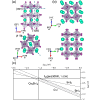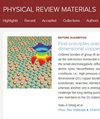Surface phase diagram of CsSnI3 from first-principles calculations
IF 3.4
3区 材料科学
Q2 MATERIALS SCIENCE, MULTIDISCIPLINARY
引用次数: 0
Abstract
is widely studied as an environmentally friendly Pb-free perovskite material for optoelectronic device applications. To further improve material and device performance, it is important to understand the surface structures of . We generate surface structures with various stoichiometries, perform density functional theory calculations to create phase diagrams of the (001), (110), and (100) surfaces, and determine the most stable surfaces under a wide range of Cs, Sn, and I chemical potentials. Under I-rich conditions, surfaces with Cs vacancies are stable, which lead to partially occupied surface states above the valence band maximum. Under I-poor conditions, we find the stoichiometric (100) surface to be stable under a wide region of the phase diagram, which does not have any surface states and can contribute to long charge-carrier lifetimes. Consequently, the I-poor (Sn-rich) conditions will be more beneficial to improve the device performance.

第一原理计算得出的 CsSnI3 表面相图
CsSnI3 作为一种用于光电器件应用的环保型无铅包晶材料,已被广泛研究。为了进一步提高材料和器件的性能,了解 CsSnI3 的表面结构非常重要。我们生成了具有各种化学计量的表面结构,进行了密度泛函理论计算,绘制了 CsSnI3 (001)、(110) 和 (100) 表面的相图,并确定了在各种 Cs、Sn 和 I 化学势下最稳定的表面。在 I 丰富的条件下,具有铯空位的表面是稳定的,这会导致价带最大值以上的部分占据表面态。在 I 贫乏的条件下,我们发现化学计量(100)表面在相图的很宽区域内是稳定的,它没有任何表面态,可导致较长的电荷载流子寿命。因此,贫离子(富含锡)条件更有利于提高器件性能。
本文章由计算机程序翻译,如有差异,请以英文原文为准。
求助全文
约1分钟内获得全文
求助全文
来源期刊

Physical Review Materials
Physics and Astronomy-Physics and Astronomy (miscellaneous)
CiteScore
5.80
自引率
5.90%
发文量
611
期刊介绍:
Physical Review Materials is a new broad-scope international journal for the multidisciplinary community engaged in research on materials. It is intended to fill a gap in the family of existing Physical Review journals that publish materials research. This field has grown rapidly in recent years and is increasingly being carried out in a way that transcends conventional subject boundaries. The journal was created to provide a common publication and reference source to the expanding community of physicists, materials scientists, chemists, engineers, and researchers in related disciplines that carry out high-quality original research in materials. It will share the same commitment to the high quality expected of all APS publications.
 求助内容:
求助内容: 应助结果提醒方式:
应助结果提醒方式:


